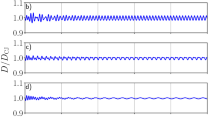Abstract
The possibility of existence of two-scale (bifurcation) structures of detonation in ammonia-oxygen, ammonia-air, and ammonia-nitrous oxide mixtures with wide-range variations of the initial parameters is analyzed. It is established that ammonia-oxygen mixtures are characterized by a classical irregular structure. Bifurcation properties are manifested if nitrous oxide or hydrogen peroxide is added. This shows that systems with bifurcation properties have certain flammability limits in terms of fuel, which are responsible for the multiscale character of the structure. The critical diffraction diameter of the detonation wave with bifurcation properties in mixtures close to a stoichiometric composition depends on the greater cell size; the presence of small-scale cells and additional “hot spots” at the points of collisions of transverse waves does not lead to any noticeable improvement of initiation. This fact contradicts the “hot spot” hypothesis, which implies that detonation initiation is facilitated if a greater number of “hot spots” are available.
Similar content being viewed by others
References
A. A. Vasil’ev, “The quasi-steady regimes of wave propagation in active mixtures,” Shock Waves, 18 (2008).
H. N. Presles, D. Desbordes, M. Guirard, and C. Guerraud, “Gaseous nitromethane and nitromethane-oxygen mixture, a new detonation structure,” Shock Waves, 6, 111–114 (1996).
N. A. Presles and D. Desbordes, “Non-ideal behaviour of multi-headed self-sustained gaseous detonation,” in: Int. Conf. on Combustion and Detonation: Zel’dovich Memorial II (Moscow, August 30–September 3, 2004), CD ROM (2004).
M. Kaneshige, E. Schultz, U. J. Pfahl, J. E. Shepherd, and R. Akbar, “Detonations in mixtures containing nitrous oxide,” in: 22nd Int. Symp. on Shock Waves, Imperial College, London, July 18–23 (1999), pp. 251–256.
A. A. Vasil’ev, A. A. Moletotov, and A. V. Trotsyuk, “On a two-scale cellular structure of gas detonation,” in: XIII Symp. on Combustion and Explosion, Abstracts, Chernogolovka (2005), p. 130; see also CD ROM: XIII Symp. on Combustion and Explosion, Chernogolovka (2005).
A. A. Vasil’ev and A. V. Trotsyuk, “Multi-scaled cellular structure of gaseous detonation,” in: Book of Abstr. of 5th Int. Seminar on Flame Structure — 5 ISFS, Novosibirsk, Russia, July 11–14 (2005), p. 82; see also CD ROM: O. Korobeinichev (ed.), Proc. of the 5th Int. Seminar on Flame Structure, Parallel, Novosibirsk (2005), OPr-08.
K. I. Shchelkin and Ya. K. Troshin, Gas Dynamics of Combustion [in Russian], Izd. Akad. Nauk SSSR, Moscow (1963).
V. I. Manzhalei and V. V. Mitrofanov, “The stability of detonation shock waves with a spinning configuration,” Combust., Expl., Shock Waves, 9, No. 5, 614–620 (1973).
A. N. Dremin, “Two-dimensional cellular structure of a kinetically unstable detonation front,” Combust., Expl., Shock Waves, 44, No. 4, 444–450 (2008).
V. Guilly, B. Khasainov, H.-N. Presles, D. Desbordes, and P. Vidal, “Numerical study of detonation cells under non-monotonous heat release,” in: Proc. of the 20th ICDERS, Monreal, Canada (2005); CD ROM.
J. Luche, H.-N. Presles, and D. Desbordes, “Influence of Ar dilution on detonation regime in H2-NO2/N2O4 mixture,” in: Proc. of the 20th ICDERS, Monreal, Canada (2005); CD ROM.
D. Desbordes, F. Joubert, F. Virot, B. Khasainov, and H.-N. Presles, “Critical tube diameter in a two reactionsteps detonation: H2/NO2 mixture,” in: Proc. of the 21th ICDERS, Poitiers, France (2007); CD ROM.
A. A. Vasil’ev, “Cell size as the main geometric parameter of multifront detonation wave,” J. Propuls. Power, 22, No. 6, 1245–1260 (2006).
A. A. Vasil’ev, “Effect of nitrogen on multifront detonation parameters,” Combust., Expl., Shock Waves, 34, No. 1, 72–76 (1998).
A. A. Vasil’ev, “Detonation properties of the synthesis gas,” Combust., Expl., Shock Waves, 43, No. 6, 703–709 (2007).
D. C. Bull, “A shock tube study of the oxidation of ammonia,” Combust. Flame, 12, 603–610 (1968).
A. N. Baratov, A. Ya. Korol’chenko, G. N. Kravchuk, et al. (eds.), Fire and Explosion Hazard of Substances and Materials and Means for Their Extinguishing [in Russian], Khimiya, Moscow (1990).
M. A. Nettleton, Gaseous Detonations, Their Nature, Effects and Control, Chapman and Hall (1987).
A. A. Vasil’ev and V. A. Vasiliev, “Ammonia: Detonation hazards, multi-structure,” in: Book of Abstr. of 4th European Combustion Meeting, Vienna University of Technology, April 14–17 (2009), p. 213; see also CD ROM: Proc. 4th European Combustion Meeting.
A. V. Trotsyuk, “Numerical simulation of the structure of two-dimensional gaseous detonation of an H2-O2-Ar mixture,” Combust., Expl., Shock Waves, 35, No. 5, 549–558 (1999).
Author information
Authors and Affiliations
Corresponding author
Additional information
__________
Translated from Fizika Goreniya i Vzryva, Vol. 46, No. 2, pp. 88–100, March–April, 2010.
Rights and permissions
About this article
Cite this article
Vasil’ev, A.A., Vasiliev, V.A. & Trotsyuk, A.V. Bifurcation structures in gas detonation. Combust Explos Shock Waves 46, 196–206 (2010). https://doi.org/10.1007/s10573-010-0030-8
Received:
Published:
Issue Date:
DOI: https://doi.org/10.1007/s10573-010-0030-8




